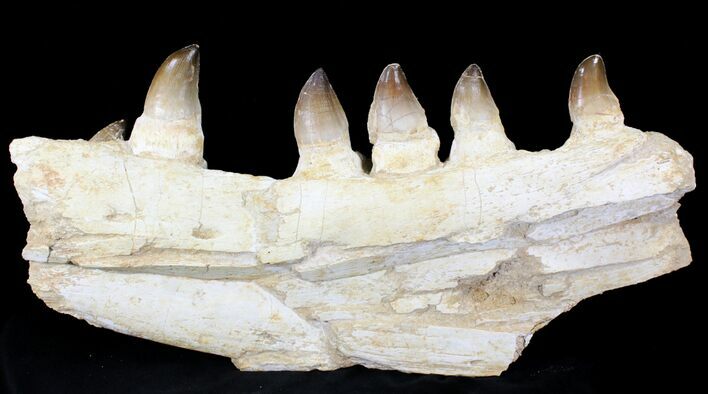This Specimen has been sold.
Large Mosasaur (Prognathodon) Jaw Section - 15"
This is a 15" long jaw section of a large type of Mosasaur, Prognathodon. It was collected in the phosphate deposits in the Oulad Abdoun Basin of Morocco and prepared to remove all of the matrix surrounding it. You can see several of the unerupted, replacement teeth growing inside the jaw on the broken end of the section. Mosasaur's like dinosaurs and sharks replaced their teeth frequently as they become worn or broken. There were teeth continuously growing inside the jaw bone, underneath and to the side the visible teeth which could move into place when tooth was lost.
Another feature that makes this specimen so unique is that it has NO RESTORATION or COMPOSITING. Mosasaurs jaws are almost always found crushed and fragmented. Whenever you see one that looks in it's in a life-like state it's because it's been put back together, missing pieces often restored, and teeth often composited. There has only been some minor repair and stabilization of cracks after the section was removed from the rock.
Please be aware that there is a huge number of fake Mosasaur jaws and jaw sections on the market. See my post: Buyer Beware: Fake Mosasaurus Jaws
Another feature that makes this specimen so unique is that it has NO RESTORATION or COMPOSITING. Mosasaurs jaws are almost always found crushed and fragmented. Whenever you see one that looks in it's in a life-like state it's because it's been put back together, missing pieces often restored, and teeth often composited. There has only been some minor repair and stabilization of cracks after the section was removed from the rock.
Please be aware that there is a huge number of fake Mosasaur jaws and jaw sections on the market. See my post: Buyer Beware: Fake Mosasaurus Jaws
Mosasaurs were a family of enormous marine reptiles that truly dominated the seas 90 million years ago, ruling during the last 20-25 million years of the Cretaceous period. With the extinction of the ichthyosaurs and decline of plesiosaurs, mosasaurs diversified to become prolific apex predators in nearly every habitat of the oceanic world.
Larger mosasaurs were the great leviathans of their time, extending 10–15 meters, or 33–49 feet long. Hainosaurus holds the record for the longest mosasaur at a seemingly impossible 57 feet. The smaller genera were still an impressive 10–20 feet long.
Mosasaurs probably evolved from semi-aquatic scaled reptiles, perhaps more similar in appearance to modern-day monitor lizards. They had double-hinged jaws and flexible skulls much like that of a snake which enabled them to gulp down their prey almost whole.
The gruesome unchewed contents of fossilized mosasaur guts have revealed a varied diet of sea birds, ammonites, smaller marine lizards, possibly sharks, and even other mosasaurs. Ammonites were especially crunchy mosasaur treats. They were abundant in the Cretaceous seas, and some mosasaurs had specialized teeth for the job.
Mosasaurs probably lurked for an ambush, rather than hunt, using their powerful tail flukes for extra thrust to dart out and swallow unsuspecting prey. Non-reflective, keeled scales may have been a great advantage to the mosasaur sneak-attack.
Mosasaurs breathed air and gave birth to live young. The bronchi leading to the lungs run parallel to each other, instead of splitting apart from one another as in monitors and other terrestrial reptiles. They were well-adapted to living in the warm, shallow, epicontinental seas of the period.
Although mosasaurs diversified and proliferated at a spectacular rate, their specialization is considered the source of their demise when marine systems collapsed at the end of the Cretaceous.
Larger mosasaurs were the great leviathans of their time, extending 10–15 meters, or 33–49 feet long. Hainosaurus holds the record for the longest mosasaur at a seemingly impossible 57 feet. The smaller genera were still an impressive 10–20 feet long.
Mosasaurs probably evolved from semi-aquatic scaled reptiles, perhaps more similar in appearance to modern-day monitor lizards. They had double-hinged jaws and flexible skulls much like that of a snake which enabled them to gulp down their prey almost whole.
The gruesome unchewed contents of fossilized mosasaur guts have revealed a varied diet of sea birds, ammonites, smaller marine lizards, possibly sharks, and even other mosasaurs. Ammonites were especially crunchy mosasaur treats. They were abundant in the Cretaceous seas, and some mosasaurs had specialized teeth for the job.
Mosasaurs probably lurked for an ambush, rather than hunt, using their powerful tail flukes for extra thrust to dart out and swallow unsuspecting prey. Non-reflective, keeled scales may have been a great advantage to the mosasaur sneak-attack.
Mosasaurs breathed air and gave birth to live young. The bronchi leading to the lungs run parallel to each other, instead of splitting apart from one another as in monitors and other terrestrial reptiles. They were well-adapted to living in the warm, shallow, epicontinental seas of the period.
Although mosasaurs diversified and proliferated at a spectacular rate, their specialization is considered the source of their demise when marine systems collapsed at the end of the Cretaceous.
SPECIES
Prognathodon sp.
LOCATION
Oulad Abdoun Basin, Morocco
FORMATION
Phosphate Deposits
SIZE
15" Long
CATEGORY
SUB CATEGORY
ITEM
#23440
We guarantee the authenticity of all of our specimens.
 Reviews
Reviews

















